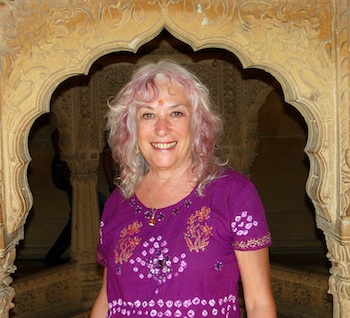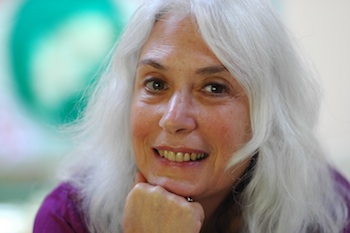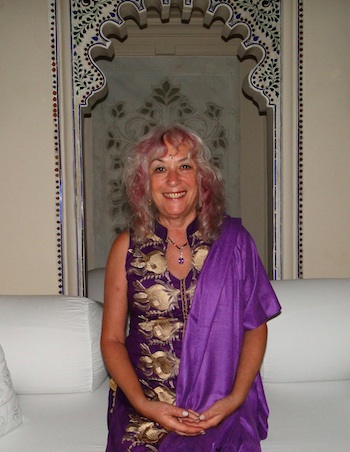 Master teacher and healer Nischala Joy Devi is revered for her innovative teachings and groundbreaking, therapeutic yoga programs for both heart disease (The Dean Ornish Program for the Reversal of Heart Disease), and cancer (Commonweal Cancer Help Program).
Master teacher and healer Nischala Joy Devi is revered for her innovative teachings and groundbreaking, therapeutic yoga programs for both heart disease (The Dean Ornish Program for the Reversal of Heart Disease), and cancer (Commonweal Cancer Help Program).
Nischala spent over 25 years as a monastic disciple with the world-renowned, Sri Swami Satchidananda, where she received his direct guidance and teachings. She applies those teachings, along with her years of experience, in her cardiac and cancer certification course, Yoga of the Heart.
She is the author of The Healing Path of Yoga, and The Secret Power of Yoga, as well as the Abundant WellBeing Audio Series. Nischala will be one of the keynote speakers at the fifth Symposium on Yoga Therapy and Research (SYTAR) in Boston, June, 2013.
Rita Trieger: In your opinion, what makes yoga therapeutic?
Nischala Devi: Having been teaching yoga for so many years, I think all yoga is therapeutic. Even without having that particular focus, yoga offers therapeutic benefits for the body and mind, and more importantly, it connects people to their spirit. There is a new wave in yoga that seems to place extra emphasis on the physical practice in an effort to get people to understand that yoga can be therapeutic, but in actuality it has always been so, without “therapy” ever being emphasized.
On the other hand, now that yoga is dovetailing with Western medicine, it’s become almost a necessity to include the word therapy or therapeutics. Doctors love the word therapy. But the fact remains that when the great masters were here, they never did anything “therapeutic,” they just taught people how to remember themselves and how to be with themselves in a higher way, which became therapeutic.
RT: Do you think that yoga in general has gained greater acceptance in the medical community for its therapeutic value?
ND: In order to include yoga in the bona fide medical community we have to prove quantitatively that it works. That is, bottom line, what the modern medical mind is looking for — proof that it works. I have been involved in many aspects of medical research and yoga. When we were working on the Ornish program study, it was easy to quantify nutrition because blood sugar can easily be measured but when it came to yoga there were no absolute measuring devices. So, what they came up with was: Does a person’s head come closer to their knee after three weeks in forward bend, than it did at the beginning? That is what they wanted to do: Measure it by literal inches. I argued that achieving a deeper forward fold doesn’t prove that a person has understood that they are practicing yoga. It’s about how comfortable they are in their whole life. And honestly, that is what proves if yoga is working. They said, well there is nothing that we can do to show that!
Truthfully, yoga is a very mystical practice and tradition, and doctors try to turn it into a very left brain, quantitative science.
RT: There is more documentation of yoga’s health benefits and people are noticing. Do you agree?
ND: Modern medicine is what we consider allopathic medicine, and allopathic means using drugs that have the opposite effect to the symptoms. For example, if someone gets a bacterial infection you give them an antibiotic. The structure in allopathic medicine is to take antibiotics three times a day, for a certain amount of time, and the results are supposed to be that you get better.
You can’t apply that same structure to yoga. Yoga is transformational. It’s something that works slowly, from the inside, and it isn’t always obvious what that transformation looks like. So I think we have to be careful about that when we move into the modern medical community. That is something that I was constantly brushing up against. We cannot compromise what we are doing because of what other people want or expect.
 RT: What are three must-have qualities that a yoga teacher or therapist should have to create the atmosphere for healing and to develop a strong student-teacher bond?
RT: What are three must-have qualities that a yoga teacher or therapist should have to create the atmosphere for healing and to develop a strong student-teacher bond?
ND: I came up with more than three. The first is that there needs to be a strong sense of humility. We need to realize that we are working with people at the most vulnerable time of their life–when they are hurting, scared, or maybe they have just been given a diagnosis. When we, as teachers, find ourselves in this kind of a situation, it’s not about what we learned in our training, it is about the energy that comes together when two people have their hearts open to each other.
There were a lot of times when I had no idea what to do with someone. I might have approached them with a set idea but when I sat in front of them something totally different happened, and I felt humbled because I could see what this person had brought out in his or her self, and in turn, had also been triggered in me. Humility is very important.
The other side of that is gratitude: “Thank you for letting me be with you in your time of need.” Being thankful that this energy and knowledge are coming through me to help you, instead of owning it and saying, “Oh I did this; I’m such a good therapist.”
Knowing your limitations or what we call scope of practice, is another valuable quality. Knowing when someone is too sick to give them alternate nostril breathing or shoulder stand. This is something that is emphasized in Western medicine — everyone knows their limits.
For example, if you go to a good cardiologist with an earache they won’t look at your ear. They will tell you to go see an ear specialist. I don’t feel that deep enough yet in the yoga community. I think a lot of yoga teachers who have read books or are into nutrition, might say to someone, “Oh, why don’t you take red yeast rice for lowering cholesterol?” They shouldn’t been saying things like that. Or, if someone is very depressed, a yoga teacher shouldn’t say, “If you do a few more inversions your depression will go away.” We have to know when we are out of the scope of our practice, and when we need to send these people to specialists.
We also need to be adaptable. It’s a fine balance and it requires going inside and saying, “Wait a minute what do these people need?” We may have planned to teach a particular practice but people may be too sick or weak, so we have to be able to tune into their needs, and change on a dime. And along with this we have to be willing to know when we are wrong. It takes humility to be able to say you made a mistake.
What makes a therapist great is compassion, and truly knowing what compassion is. Compassion is the catalyst that makes healing happen. People only really want to know that someone cares about them. It doesn’t matter if you succeed or not, what matters is that our hearts are together. That kind of compassion is really the pinnacle that holds all of this together. So much of that is missing in the medical community these days. As good yoga therapists, we need to bring that compassion back in, which is the main aspect of yoga. But how do we train someone to be compassionate?
RT: Do you think that along with traditional yoga teacher trainings, is it important to have some sort of certification process to become a yoga therapist?
ND: Absolutely. Most professions have a certification or licensing. You can’t have a profession and just let people go out and do what they want. There has to be specific certification training.
You can train someone in asana and teach them to adapt this way for heart disease and that way for cancer; I do that. But when it comes to training people to be compassionate and humble, that is difficult because it’s not something that can be quantified, so I think this is our real challenge in these certification programs.
I also think people have to spend time in retreat getting to know themselves before they can become a therapist. We need to go into ourselves and discover our hopes and fears. All psychotherapists have to undergo some kind of therapeutic analysis in their training. I think it’s important to have that introspection because essentially that is yoga.
We have to learn to teach the people in front of us, and that takes a lot of experience — not 1,000 hours, not even 5,000 hours. It can take years to develop that intuitive sense. When we become therapists, we have to become therapists, not just yoga teachers that are learning a little about therapy.
I think continuing education is important in the certification process. Most people love asana because it is clear cut but it should not be the only focus. We are not only continuing our education to enhance our ability to be therapeutic but to continue to enhance who we are as our understanding grows. This is difficult to regulate, and each person has to find that within his or her self.
 RT: Within a person’s healing process do you think that yoga is most beneficial as prevention, after being diagnosed, or as an ongoing curative therapy?
RT: Within a person’s healing process do you think that yoga is most beneficial as prevention, after being diagnosed, or as an ongoing curative therapy?
ND: Yes! Of course, I always wish for people to come to yoga for prevention. There is nothing like it. There is nothing like having the ability before something happens. Even if the person has risk factors, you are still working with someone who has strong vital energy, and their course can be easily corrected at that point. Once they have the disease, it’s much more difficult because then the person is dealing with the shock of the diagnosis, the treatment or perhaps possible weakness of the body post-surgery. It’s difficult to give someone who is low on energy and already has a full plate more to do. Yet we have seen great results.
Take someone who has heart disease. They might resist or think they know better but that same behavior they are bringing to yoga class is the same behavior that got them heart disease in the first place. We just have to slow it all down and pull them back. I never put emphasis on that forward bend, my emphasis was about the ease in which a person moves into the forward bend and holds, and the ease with which he or she moves out of it. It’s not competitive, it’s just relaxation.
So the important thing is that people do yoga, no matter what the stage of healing. It can’t just be that they read about it —they actually have to do it, and then I think there is a health benefit at any stage.
RT: Where would be a good place for a person to begin if they want to use yoga therapeutically?
ND: Do it now. And find the right yoga therapist, which can be tricky because anybody and everybody are calling themselves yoga therapists. Pairing up the therapist and the client is probably the most important thing.
My advice is to look for someone who is well-trained, though it’s not just about being well-trained, because lots of people are well-trained. It’s important to look for someone who meshes with your personality. True healing takes place when two people are in alignment with each other. Who do you feel most comfortable working with in such an intimate way?
Personality wise, a therapist should have the ability to go within themselves to get the answers. When I began with the Ornish program there were no role models; we had to invent it as we went along. What I had to do most of the time, was go inside and explore what felt right and then bring it out.
RT: What do you do in your practice to help you stay balanced?
ND: My favorite quick balancing practice is alternate nostril breathing. I would recommend practicing three to five minutes of it between clients. You can even breathe in a particular word, such as breathing in gratitude and breathing out peace. Or if you can’t do alternate nostril, just do full deep breathing. Make it an easy. It helps bring us back to who we are.
Often people will unknowingly pull us into who they are, and we need to be strong enough in who we are, at our very essence, in order to withstand that intense energy draw. Bring yoga back to the intuition. You know what you need: You may need more relaxation on any given day, or you may need more breathing.
Make sure that you are not taking on more than you can handle; you have to be realistic. If someone is really sick or you are teaching six classes of very sick people in one day, it’s too much. It’s not like teaching a regular class. We have to be aware that these people are needy and in order to give them enough we have to be well rested, well fed, and our practice has to be deep. It’s not just about asana practice; we have to develop the subtle practices: pranayama, meditation, journaling — things that take us into ourselves.
Make sure there is time between classes and clients, and be honest enough to say to yourself that taking on another very sick person may be too much, and then help them find another therapist. The longer and the deeper your own practice is, the less you are thrown off, and the less you will feel the need to do too much. Have compassion for yourself and be grateful for the energy that is coming though.
One of my favorite practices is from the yoga sutras. It is called pratipaksha bhavanam, which means to cultivate the opposite, positive experience. Take in anything negative and change it into something positive. For example, if someone says to you, ‘I’ve just been given three weeks to live and I don’t know what to do about it,’ and you are left holding that image you can change the image by seeing the essence of spirit in that person and that take you out of the negative loop.
We tend to get sucked into negative loops which destroy a lot of our life force. Instead, see things in a positive light: a person has three weeks left to really remember who they are, and in that knowledge everything changes. This practice will help you to stay centered: I know what I know, and who I am. I am a good person. I am doing the best that I can, and that is all that I can do. Flip the negative into a positive.
RT: Is there anything else you’d like to add?
ND: We have to get back to the realization that yoga is not the practices. Yoga is knowing who we are within ourselves, and then cultivating the ability to touch that spirit.
It will be interesting to see how it all turns out. We are entering into an unknown territory when we are certifying people. I like the old idea of mentorship, which is still used and important in hospital settings. Find someone who has been doing this kind of work, and watch them. Watch who they are, not just working with other people, but watch who they are as they live their lives. That is what is going to come across when you are a therapist. Who you are in your life — that is the magic in it.

Nischala Joy Devi will be a keynote speaker at the upcoming Symposium on Yoga Therapy and Research (June 13-16) by the International Association for Yoga Therapists (IAYT). The early bird deadline for the conference has been extended through May 13. For more information on SYTAR, visit: iayt.org.
Rita Trieger is a contributing editor of Find Bliss, and the author of Yoga Heals Your Back (Fairwinds, 2005). She teaches Yoga therapy for both cancer and heart patients at Stamford Hospital in Stamford, Connecticut. Ritatude.blogspot.com
Rita Trieger is a yoga therapist working in New York and Connecticut.
